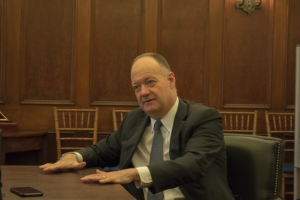Undergraduate tuition to attend Georgetown University for the 2019-20 academic year is set to increase by 2.8 percent to $55,440 from $53,929 marking the eighth consecutive year the university’s undergraduate tuition has risen.
Georgetown University Provost Robert Groves announced the tuition raise for the upcoming academic term in a Jan 16. campuswide email. The tuition hike is down from the 3.5 percent increase observed last year. This decrease can be attributed to the planned removal of a mandatory Yates Field House membership fee, according to Groves.
Yates’ operations will not be affected by the fee’s elimination, according to Georgetown University Director of Strategic Communications Rachel Pugh. Instead, students will now have have access to Yates through their tuition, Pugh wrote in an email to The Hoya.
The mandatory Yates membership fee costs students approximately $222 per semester, according to GUSA press secretary Jonathon Marek (SFS ’21).
However, even with the marginal decrease, Marek said the tuiton’s growth rate should be lower compared to that of peer universities, citing a national average of 2.3 percent for private four-year institutions.
“We urge the administration to take action to further reduce the rate of tuition increases in years to come,” Marek wrote in an email to The Hoya.
Housing fees will also rise 1.9 percent for all on-campus housing, except for townhouses, which will increase in cost by four percent.

The university is working hard to reduce spending while maintaining the university’s commitment to education and funding scholarships, according to university spokesperson Matt Hill.
Groves used the announcement to highlight the university’s $218 million allocation to financial aid, its largest investment to date. The university’s admissions process does not consider financial need when reviewing applications and commits to meeting all demonstrated need, Groves wrote.
A minority of universities nationwide operate on need-blind admission policies, which prohibit the university from knowing an applicant’s financial status during the admission process while also promising to meet full need as Georgetown does. However, many of Georgetown’s peer schools such as the University of Chicago and Ivy League colleges share Georgetown’s policy.
The university expects to spend 21 percent of tuition revenue on financial aid, according to a projection of expenses in the campuswide email. Educational instruction is anticipated to encompass 43 percent of tuition revenue.
Tuition is still prohibitively costly for many prospective Georgetown students, Marek wrote.
“Significant progress has been made; however, more work is still necessary to ensure that a Georgetown education is accessible to all students, regardless of their financial background,” Marek wrote.
Georgetown provides some form of need-based financial aid to nearly 40 percent of its undergraduates, Hill wrote. Many of Georgetown’s peer universities, however, have higher rates of students receiving financial aid: 50 percent of undergraduates at Columbia University receive financial aid, 46 percent at University of California, Berkeley, and 43 percent at Duke University, according to U.S. News and World Report.
Increases in the tuition rate have previously sparked vocal pushback from students, including protests from undergraduates in 2016 spearheaded by a group called “Hoyas Against the Hike.”
In his campuswide email, Groves acknowledged the burden put on students in increasing tuition.
“We are very much aware of the significant investments students and families make to pursue a Georgetown education,” Groves wrote.




















